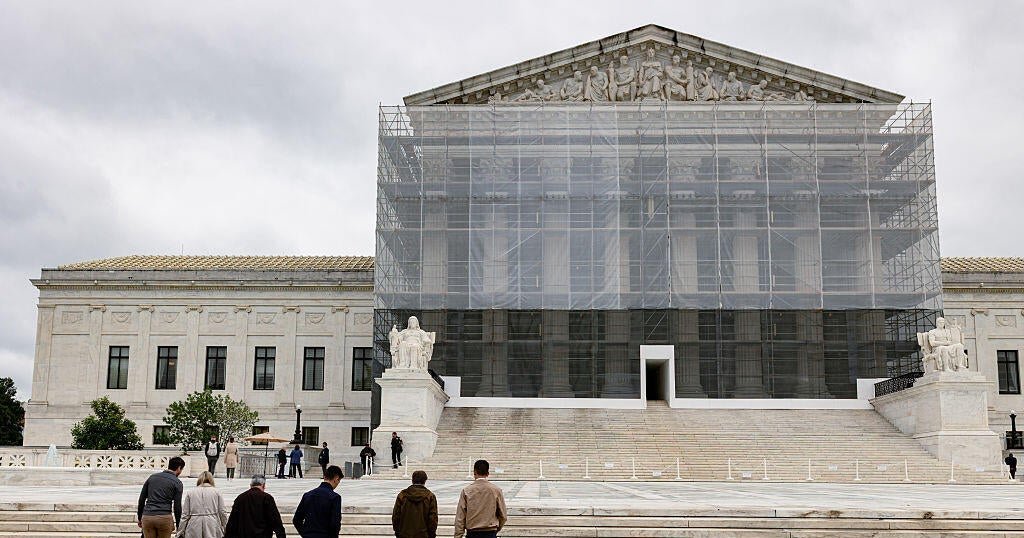Washington — The Supreme Court on Tuesday lifted a lower court order that blocked sweeping layoffs of federal workers at nearly two dozen agencies while a legal battle over President Trump’s plans to drastically cut the size of the government moves forward.
The high court’s order clears the way for the Trump administration to resume its efforts to reorganize and scale back the federal government, which has been led by the White House’s Department of Government Efficiency, or DOGE.
The Justice Department turned to the Supreme Court for emergency relief after a federal judge in May ordered a halt to the job cuts and enforcement of other orders by DOGE to slash programs or staff.
In a brief unsigned opinion, the Supreme Court said that the injunction issued by the district court was based on its view that Mr. Trump’s executive order and directives from the Office of Management and Budget and Office of Personnel Management implementing that action are unlawful.
“Because the government is likely to succeed on its argument that the executive order and memorandum are lawful — and because the other factors bearing on whether to grant a stay are satisfied — we grant the application,” the court said. “We express no view on the legality of any agency [reduction-in-force] and reorganization plan produced or approved pursuant to the executive order and memorandum. The district court enjoined further implementation or approval of the plans based on its view about the illegality of the executive order and memorandum, not on any assessment of the plans themselves. Those plans are not before this court.”
Justice Ketanji Brown Jackson dissented from the court’s decision and accused it of demonstrating an “enthusiasm for greenlighting this president’s legally dubious actions in an emergency posture.” Justice Sonia Sotomayor wrote in a separate statement that while the president cannot restructure federal agencies in a way that is inconsistent with congressional mandates, the agency plans for reductions-in-force are not yet before the Supreme Court.
“[W]e thus have no occasion to consider whether they can and will be carried out consistent with the constraints of law,” Sotomayor wrote. “I join the court’s stay because it leaves the district court free to consider those questions in the first instance.”
The legal battle
Mr. Trump began taking steps to shrink the government shortly after he returned to the White House. The president created DOGE, a cost-cutting task force that had been led by Elon Musk, and his administration began taking steps to dismantle agencies like the U.S. Agency for International Development and the Consumer Financial Protection Bureau.
In February, Mr. Trump issued an executive order directing agencies to make plans to initiate “large-scale” reductions-in-force, the government’s term for layoffs. On the heels of the president’s directive, the Office of Personnel Management and the Office of Management of Budget issued a memo directing agencies to submit plans for two phases of job cuts.
Several department heads began executing their workforce cuts earlier this year, with thousands of federal employees losing their jobs. Other federal entities had planned to make significant reductions in the coming weeks and months. The reductions-in-force are separate from the mass terminations of probationary workers, who generally were in their positions for one or two years. But those firings, which took place in February, have also been the focus of lawsuits.
In response to Mr. Trump’s executive order, labor unions, nonprofit groups and local governments sued nearly every federal agency to block the layoffs, arguing that the executive order exceeded the president’s authority and violated the separation of powers. The Department of Education was not part of the unions’ suit.
A federal judge in San Francisco agreed to issue a temporary restraining order that prevented the Trump administration from moving forward with its existing reductions-in-force or planning any future layoffs as directed by Mr. Trump. The order also bars administration officials from enforcing any further orders by DOGE to cut programs or staff in connection to the president’s executive order.
U.S. District Judge Susan Illston extended that block in May, finding that the president can restructure federal agencies, but only after obtaining approval from Congress. Her injunction applies to 22 federal agencies, including the Cabinet-level Departments of Agriculture, Health and Human Services, and State, among others.
“Presidents may set policy priorities for the executive branch, and agency heads may implement them. This much is undisputed,” Illston wrote. “But Congress creates federal agencies, funds them, and gives them duties that — by statute — they must carry out. Agencies may not conduct large-scale reorganizations and reductions in force in blatant disregard of Congress’s mandates, and a president may not initiate large-scale executive branch reorganization without partnering with Congress.”
The Trump administration turned to the Supreme Court after the U.S. Court of Appeals for the 9th Circuit declined to lift Illston’s order. The appeals court said in a 2-1 decision in late May that Mr. Trump’s executive order “far exceeds” his supervisory powers under the Constitution.
In arguing for emergency relief from the Supreme Court, Solicitor General D. John Sauer said the district court’s order is “flawed” and rests on an “indefensible premise,” namely that the president needs authorization from Congress to oversee personnel decisions within the executive branch.
“It interferes with the Executive Branch’s internal operations and unquestioned legal authority to plan and carry out RIFs, and does so on a government-wide scale,” he wrote. “More concretely, the injunction has brought to a halt numerous in-progress RIFs at more than a dozen federal agencies, sowing confusion about what RIF-related steps agencies may take and compelling the government to retain — at taxpayer expense — thousands of employees whose continuance in federal service the agencies deem not to be in the government and public interest.”
Lawyers for the unions urged the Supreme Court to reject the Trump administration’s request for emergency relief and warned that allowing Mr. Trump to move forward with his planned reorganization of the federal government before the merits of the case can be decided would do irreversible damage.
“[O]ffices, and functions across the federal government will be abolished, agencies will be radically downsized from what Congress authorized, critical government services will be lost, and hundreds of thousands of federal employees will lose their jobs,” they wrote. “There will be no way to unscramble that egg.”
The unions said that if the injunction remains in place, it would not prevent the president from going to Congress and securing its approval for a reorganization of the government.
#Supreme #Court #clears #Trump #move #mass #layoffs #federal #workers



